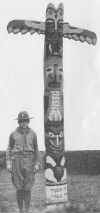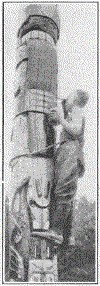By Robert De Groat
 Color
Detail of Totem
Color
Detail of Totem
Three crouching human figures with headds, part human, form the principle design of the wolf head totem, left.
The lower one has a broad nose, projecting front teeth, and animal ears.
The principle figure has upon its head one of those cylindrical objects of a blue color which are placed on dance hats, and against this leans the next figure, whose feet cannot be seen. It has a hooked nose turning into the mouth, and the ears of an animal.
The third figure is squatting with its arms and legs in a sitting position, and has a wolf's head.
In all three figures, arms, legs, mouth, face, nostrils, and ear-holes are scarlet. Eyebrows, eyeballs and edges of ears are black.
Meaning of Totem Pole Colors
WHITE: This color is used, along with other light colors, as a background and predominating shade. As a rule it symbolized the skies and spacious heavens. It also stood for purity, peace, and death.
Red: Generally this color stands for blood, war or valor. Sometimes it is used as appears in nature, such as the crest of a red-headed woodpecker, the scarlet tanager or frequently the tongue of an animal.
Blue: This color was most commonly used as the symbol for the rivers, waters, and lakes, also the skies. Certain tribes even used used it for mountains in the distance. It stands for sincerity and happiness. Berries formed a large portion of the natural materials for this color. Western clay and pigments of the canyons also lent varying hues to this effective color.
Yellow: The natural abundant materials made this color a very popular and predominating one. Clays, roots, and tannic barks furnished the natives with dyes. Yellow reflects the symbol of the sun, light and happiness. Yellow dye is readily make from tree moss.
Green: It may easily be realized that this color represents the earth, the hills, the trees, and mountains, so common in all Indian legends.
This color may be obtained by mixing two primary colors, yellow and blue, or it may be made from simple acid action on copper. In certain sections of the west and northwest copper was rather abundant. Other parts of the country used the juice of grasses.
PURPLE: Huckleberries give a very good substance for dyeing and the Indians used this commonly. Purple is an excellent color for recessed Portions of the carving and for symbols of a reverent nature. It stood for mountains in the distance and general conventionalized signs.
BLACK: Mud from sulphur springs and other earth deposits made this color available to the Indian. As a rule it stood for power.
Painting the Totem
After the pole or object of craftsmanship has been completed and the incised parts carefully cleaned out to give sharp, distinct markings and shadows, preparations for painting should start.
Where knots are conspicuous and when fairly unseasoned wood has been used, it is advisable to give them a coating of shellac to prevent the resin from running out and spoiling the finished effect.
Be sure the object is clean and that all particles of dust and dirt have been removed.
There are two common ways of painting the pole. One is while it is on the horses or on the ground, and the other method is to paint it after it is erected. If the pole is fairly short a better finished job can be accomplished after it has been erected, as nicks and rope rubs will be avoided.
Some people, however, prefer to paint even large poles after they are erected, contending that one can see the pole as it looks from a distance, and thus make improvements in color effects not realized or visualized in the rough preliminary studies and sketches. You can see in the illustration (Treasure Island Philadelphia Camp) that this Scout preferred to paint the pole after it was up and has used the steeplejack method of slinging a rope around and adjusting it as he painted.
Colors
The Indians originally used pigments made from clay and roots. The colors were very bright and became subdued after the pole had weathered several winters. The symbolism of the colors changed a little in different parts of the United States. Therefore we have attempted to give only a general meaning to the prevalent shades.
There are three primary colors--red, blue, and yellow. From these three colors any other colors may be created by the correct combination and mixing. However, nowadays colors come already mixed in practically any shade you desire, at a price that depends mainly on the quality.
For large camp work a reasonably priced paint is perfectly good enough. On pieces of carving or other objects mentioned in the discussion of Craftsmanship Gifts, etc., it will often be better to use a more expensive grade of paint. Enamels, lacquer, Duco and common show-card colors may be used, the object, the object cannot be subjected to much handling or water as the tempera (show-card color) is not permanent.



